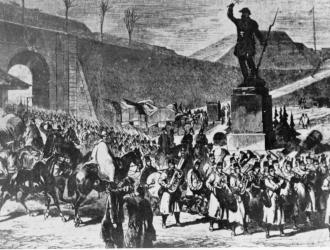
FREDERICIA RAMPART
The fortress was constructed using the same technique which was used in the beginning of the 17th Century in among other countries Italy, France and the Netherlands. This type of fortification is characterized by the use of earth works and wide water filled moats. Then you had a deep defense which wasn't as vulnerable to bombardment from artillery as for example stone walls.
Facing land 7 full and two half bastions were built. The perimeter was little less than two kilometers and the whole of the rampart complex covered 103 hectares. Facing the sea a somewhat weaker fortification was constructed. The distance between the bastions was defined by the range of the musketers (approximately 250 – 300 meters). The size of a bastion at the foot of the slope is approximately 20.000 square meters which is equivalent to three football grounds.
The width of the rampart is 60-70 meters at the base and approximately 40 meters at the top. The height above street level is 6 – 8 meters more or less. On top of this parapets, traverses and cavaliers were added. The King´s Bastion (Kongens Bastion) is 15 meters above street level and this is the highest point of the Rampart. Farmers from the most of Jutland together with soldiers and convicts were appointed and made up the work force. This numbered at times up to 5.000 workers. The first construction period lasted from 1650 until the Swedish attacked and occupied the town in 1657.
Most of the earth needed for building the Ramparts was dug from the terrain immediately outside the rampart as well as from digging the moat. Apart from this turfs were cut from a big area surrounding the town to cover the constructed earthwork. Today we think that all the bastions were constructed as open bastions – in the same way as Schleswig Bastion presently.

Before leaving Frederiksodde (Fredericia since 1664) in 1659 the Swedish forces burnt and looted most of the town and destroyed the fortress. After this the fortification wasn´t finished until 1675. As a result of the bad economic situation of the country after the Dano-Swedish wars in the 17th Century only small funds were allocated to the maintenance from 1675 to 1710. During this period cattle grassed everywhere on the Ramparts until the citizens were ordrerd to keep their livestock (sheep, pigs, horses, cattle) out of the area. When this didn´t solve the situation the commanding officer ordered the soldiers to hunt the cattle. Pigs were executed on the spot showing no mercy whereas horses and cows were captured and tied to the Main Guard. Here the owners could have them handed over – though paying a fine first.
Because of the threats from the Great Northern War a main restoration was carried out in 1710 and the following years. After this the fortress was kept in good condition until 1760 and hereafter it fell to decay again.
In 1749 no less than 450 heads of cattle which illegally grassed on the slopes of the ramparts were captured and the year after a rampart keeper was hired provided with the privilege to shoot down livestock on the rampart. This arrangement came to an end in 1764 and caused trampling down and cropping of the terrain. When the First Schleswig War broke out in 1848 the fortress was in such a bad condition, that repair was given up in the first place. By the resumption of the war in 1849 an extensive reconditioning was carried out in only 3 months under commander Colonel Lunding´s skilled leadership. After celebrating the 6th of July victory the same year no more money was used for maintenance until greater alterations were organized from 1861 to 1863. Prince Georg´s, Prince Christian´s and the Queen´s Bastions were reconstructed according to new ideas of defence.
In the years after the Danish defeat at Dybbøl in 1864 the authorities realised that earth ramparts had had their day as defensive constructions and the fortress therefore was abolished in 1909. In 1914 the municipal authorities bought the terrain of the rampart which became a protected area in 1917.